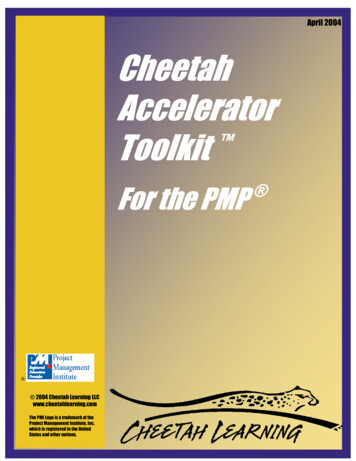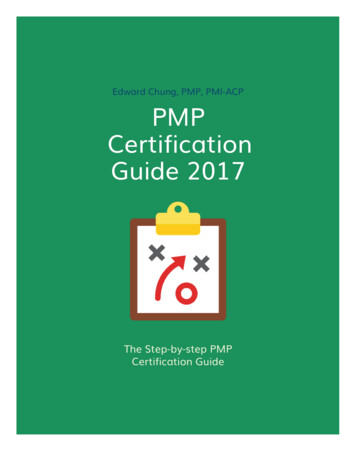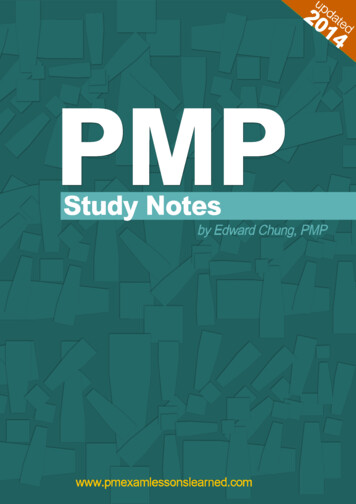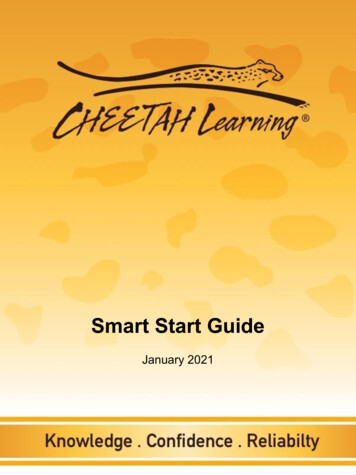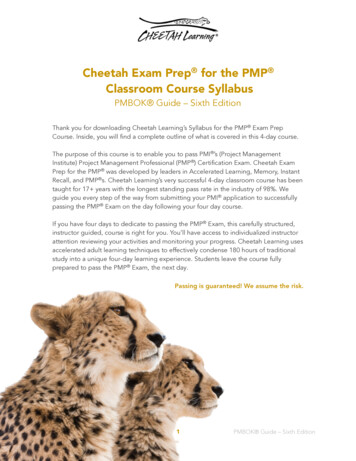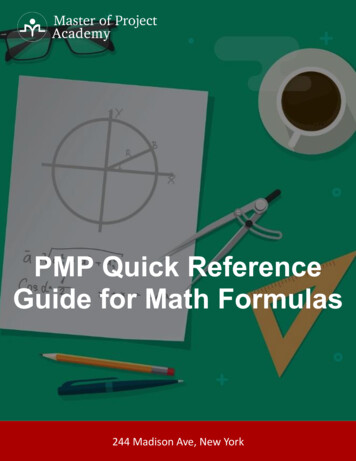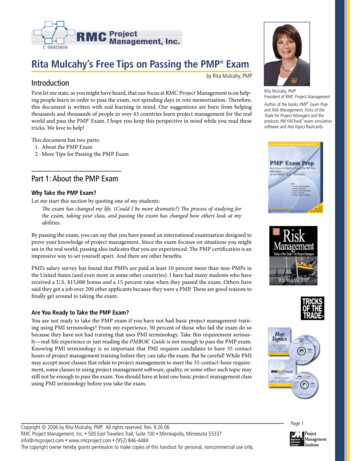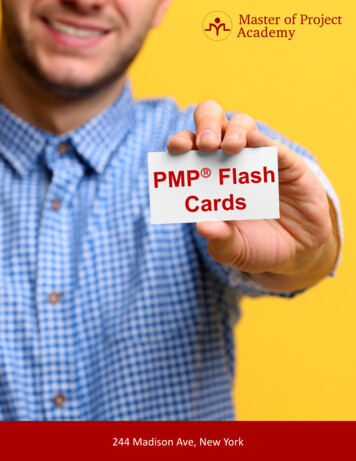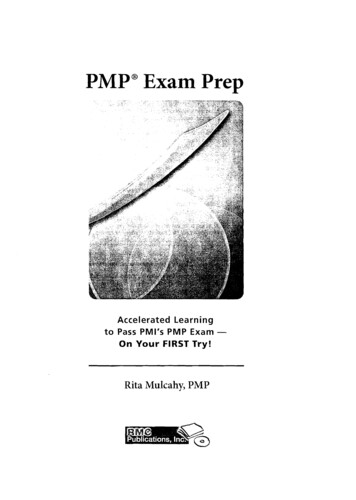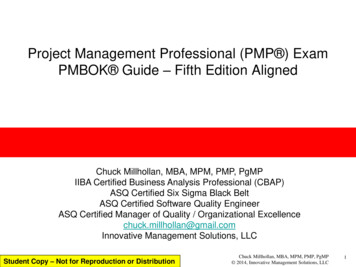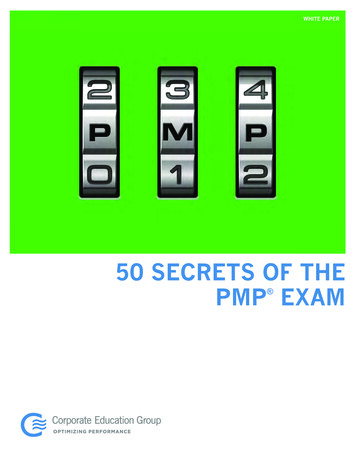
Transcription
WHITE PAPER50 Secrets of thePMP Exam
The Project Management Professional (PMP) Certification from the ProjectManagement Institute (PMI) is the most in-demand certification in the projectmanagement category. It’s also one of the most challenging certification exams topass. The industry is littered with tales of earnest PMP seekers who thought theystudied enough, prepared enough and were experienced enough to pass the test,but who failed miserably—sometimes more than once. Informal polls indicate thatas many as 40 percent don’t pass on the first try.You don’t have to be one of the 40 percent. Kicking off with overall project management concepts andthen organized by each of the 10 Knowledge Areas, we’ve compiled must-know PMP Exam tips, tricksand strategies on everything from:nw hich pages of A Guide to the Project Management Body of Knowledge (PMBOK Guide) matter most;na reas of the PMBOK Guide that merit a second read;nv arious memory joggers and easy to memorize formulas;nk ey terms, confusing terms and terms to avoid; andnm uch, much more!Whether you are consideringtaking the exam for your first timeor you’re going back at it foranother try, these 50 Secrets ofthe PMP Exam will help you stayahead of the curve andFast Track Your Way toPMP SUCCESS!50 Secrets of the PMP Examwww.corpedgroup.com/fasttrack2
What You Need to Know:Project Management Concepts123 When you see questionsWithin the PMBOK Guide,For the exam, you mustpage 25 is critical. Theassume proper projecttable on this page showsplanning was done beforethe relationship betweenthe project work began. Youeach process and itsneed to get your mindassociated Knowledgearound the critical differenceArea and Process Group.planning makes and assumeWe recommend that youthe project has been properlymemorize this page orplanned as you answer theknow it very, very well. Inquestions. It is surprisingmany cases, the majority ofhow few project managersthe exam questions you willcreate a realistic plan or get itsee will be related in someofficially approved. In the realway to having knowledgeworld, and in the world of theabout the Process Groupsexam, that would be a hugeand Knowledge Areas.mistake.on the exam regardingorganizational structure,be sure you know whichstructure the question isrelated to. The right answerwill depend on it.50 Secrets of the PMP Examwww.corpedgroup.com/fasttrack3
1The First Knowledge Area:Project IntegrationManagement56Here is a trick to understanding the topic of management plans for the Scope Schedule Cost Quality Resources Communications Risk Procurement StakeholderPlease note the confusing terms. If the exam refers to Direct and Manage Project Work, it is NOT referencing the entireexecuting process group. Instead, it is just referring to the integration piece of executing.7Integrated change control is an important topic to know. Approximately 10% of the exam questions touch on this onetopic from different angles.8Be sure to remember for the exam that as project manager you always close out a project, no matter the circumstancesunder which it stops, is terminated, or is completed.9Whenever the PMBOK Guide mentions “expert judgment,” do not assume it is referring to an executive decision beingtaken by the project manager. Expert judgment is usually obtained from the subject matter experts, and this may includethe project manager.50 Secrets of the PMP Examwww.corpedgroup.com/fasttrack4
23The Second Knowledge Area:Project Scope Managementqfollowing reasons:It identifies deliverables and their acceptance criteria. This ensures acommon understanding with stakeholders about the scope and increasesthe likelihood that the scope validation process will go smoothly.It documents the project exclusions, thereby reducing the likelihood of scope creep.weAlways remember that the scope management plan doesn’t contain the project scope. The scope management plan isa component of the project management plan that tells how scope will be identified, managed and controlled.PMBOK Guide does notrPMBOK tdetailed in theGuide, it is valuable to familiarize yourself with them.Scope process should be performed for every project deliverable, or a group of deliverables, beingpresented to the customer or sponsor.The Third Knowledge Area:Project Schedule ManagementyFor the Exam, yused for both time and cost estimates.Three-Point Estimate (Beta Distribution) (P 4M O) / 6Activity Standard Deviation (P-O) / 6Activity Variance [ (P-O) / 6 ] 2uan easier way testimates also allows for quick calculations and proof that you understand those concepts.iThe Plan Schedule Management process produces the project’s schedule management plan. It does not contain theproject’s schedule. It only describes how the project’s schedule will be developed, managed, and controlled.oAlthough the PMBOK Guide does not mention it, analogous estimating is often used as a method for “top-down estimating.”pPractice the forward pass and the backward pass on a schedule network and make yourself comfortable with it.Many people struggle with this and incorrectly compute the early and late start and finish dates.50 Secrets of the PMP Examwww.corpedgroup.com/fasttrack5
4The Fourth Knowledge Area:Project Cost ManagementaMake sure to MEMORIZE the following: Rough Order of Magnitude (ROM) Estimate- This type of estimate is usually made during theinitiating process.- A typical range from ROM estimate is from -25% to 75%from actual, but this range can vary depending on how muchis known about the project when creating the estimates. Budget Estimate- This type of estimate is usually made during the planningphase and is in the range of -10% to 25% from actual. - Later during the project, the estimate will become morefrom actual, while others use -5% to 10% from actual.sdBe very careful when interpreting the SPI and CPI values. Although values greater than 1.0 are desirable, values greaterthan 1.5fmean the project was not properly estimated earlier.Understand the concepts behind the EAC formulas. This will help you select the right formula to crack a question onyour exam.gThe PMBOK Guide page 267 is critical; it summarizes all the earned value formulas. Memorize these formulas and doa brain-dump of these formulas on a piece of paper before you begin your exam.50 Secrets of the PMP Examwww.corpedgroup.com/fasttrack6
56The Fifth Knowledge Area:Project QualityManagementhRemembering the following phrases about Pareto charts shouldhelp you on the exam:j Help focus attention on the most critical issues. Prioritize potential “causes” of the problems. Separate the critical few from the uncritical many.Remember the difference between grade and quality. Grade refers to the characteristics of a product, while quality refersto conformance to customer requirements.kPrecision is different than accuracy. Accuracy is the closeness of a measure against the target, while precision is thecloseness of the repeated measurements with each other.lThe Sixth Knowledge Area:Project ResourceManagement;For the exam, MEMORIZE the top four and remember that Personality is last.1.2.3.4.zScheduleProject prioritiesResourcesTechnical opinions5. Administrative procedures6. Cost7. PersonalityThe PMBOK Guide doesn’t discuss organizational theory in much detail. However, expect some questions on this area.While this may not explicitly be mentioned in the PMBOK Guide, it is valuable to familiarize yourself with organizationaltheory.xIt is very important to understand Tuckman’s Ladder or the Tuckman’s Team Development Stages. There will almostcertainly be a question on the PMP exam around it.cColocation and virtual teams are two totally opposite techniques. You must understand the pros and cons of both andbe able to identify the most suitable option for any given situation.vAlways remember, the team members having a conflict are initially responsible for its resolution.50 Secrets of the PMP Examwww.corpedgroup.com/fasttrack7
7The Seventh Knowledge Area:Project CommunicationsManagementbReview the basic communication model (Figure 10.4) and sequenceof steps involved in the model as outlined in the ProjectCommunications Management section of the PMBOK Guide.nManaging communication deploys the communications managementmMonitoring communication is concerned with ensuring that the communications management planis being used effectively and adjusting it as necessary.50 Secrets of the PMP Examwww.corpedgroup.com/fasttrack8
8The Eighth Knowledge Area:Project Risk Management, The following are examples of risk management errors that you wantto avoid or be aware of for the exam:nnn isk identification ends too soon, resulting in a brief list ratherRthan an extensive list. he processes of Identify Risks through Perform Quantitative Risk Analysis are blended, resulting in risks that areTevaluated or judged as they come to light. This decreases the number of total risks identified and causes people tostop participating in risk identification.n The risks identified are general rather than specific.n Some things considered to be risks are not uncertain; they are facts, and are therefore not risks.n Whole categories (technology, cultural, marketplace, etc.) of risks are missed.nn. isk identification is completed without knowing enough aboutRthe project. nly one method is used to identify risks rather than a combination of methods. A combination helps ensure that moreOrisks are identified. he first risk response strategy identified is selected without looking at other options and finding the best option orTcombination of options.n Risk management is not given enough attention during project executing.n Project managers do not explain the risk management process to their team during project planning. Notice that an updated risk register is the only output of several of the risk management processes. Read examquestions carefully, as the risk register contains different information depending on when in the risk managementprocess the question is referencing./Remember that the project risk is always in the future. If a risk occurs, it is no longer a risk; it is either an issue ora realized opportunity.QRemember that the Perform Qualitative Risks analysis is quicker but less accurate than the Perform Quantitative RiskAnalysis process.WPractice the expected monetary value analysis and decision tree analysis techniques. You can expect to see questionsthat cover these techniques on the exam.50 Secrets of the PMP Examwww.corpedgroup.com/fasttrack9
910The Ninth Knowledge Area:Project ProcurementManagementEIn practice, the company or person who provides services and/orgoods can be called a “contractor,” “subcontractor,” “designer,” orother titles. The PMBOK Guide uses only one term, “seller,” but theexam may use any of these terms to describe the seller. The companyor person who purchases the services is called the “buyer.”RThere are three basic types of contracts. Each one has its place and use. You must understand the differencesand especially understand how different contract types determine the final costs of a contract.TUnderstand the difference between the procurement management plan, procurement strategy, procurement statementof work, and the bid documents.YRemember that the contract change control procedures are usually documented in the procurement agreements.UAlways remember that negotiation is the preferred procurement conflict resolution technique.The Tenth Knowledge Area:Project StakeholderManagementIPlease note that the project stakeholders’ influence is at themaximum during the start of the project and reduces graduallyas the project progresses.OThe Identify Stakeholders process is an initiating process.However, it must be periodically revisited to ensure that theproject’s Stakeholder Register is always up to date.P Review the Power/Interest Grid information given in the PMBOK Guidepage 512. There will most certainly be questions that pertain to this grid on the exam.A50 Secrets of the PMP Examwww.corpedgroup.com/fasttrack10
You’ve Got the Tips. Now What?These invaluable insights into the PMP Exam are just one tool that you should leverage on your journey towards becomingTo ensure your successPMBOK Guide and build on your real-worldexperience to get you in a PMP frame of mind.PMP Prep Fast Track from Corporate Education Group (CEG) is a five-day immersion course that combines the provenproject management training from one of our most popular and longest-running courses with a fresh approach to exampreparation. PMP Prep Fast Track is packed with exercises, practice exams, and study aids to ensure you successfullyearn the industry’s most sought-after credential.As each of the 10 project management Knowledge Areas in the PMBOK Guide are presented, you will learn professionalkeep cost, schedule, scope and other critical project factors under control throughout the project life cycle.Course Highlights: Dozens and dozens more Exam Tips just like the ones shared here A simple step-by-step process to successfully navigate the entire journey from the application to test day Ninety days of access to a Powerful Exam Simulator that mimics the real thing Taught by PMP Certified instructors Take it in a traditional classroom, virtually with a live instructor or bring it on-site to your organization if you havea team to trainFor more information and to register forPMP Prep Fast Track, visithttp://www.corpedgroup.com/fasttrackor call 1.800.288.7246.If you are serious about advancing yourcareer and are ready to earn on average 16percent more than your peers1, contact CEGand Fast Track Your Way to PMPSUCCESS!50 Secrets of the PMP Examwww.corpedgroup.com/fasttrack11
aBoUt ceGCorporate Education Group (CEG) delivers talent strategies and development solutions that align with targeted businessgoals to transform organizational performance. From assessments to advisory consulting, program design, training de
PMBOK Guide does not detailed in the PMBOK Guide, it is valuable to familiarize yourself with them. t y The Third Knowledge Area: Project Schedule Management For the Exam, y used for both time and cost estimates. Three-Point Estimate (Beta Distribution) (P 4M O) / 6 Activity Standard Deviation (P-O) / 6 Activity Variance [ (P-O .
